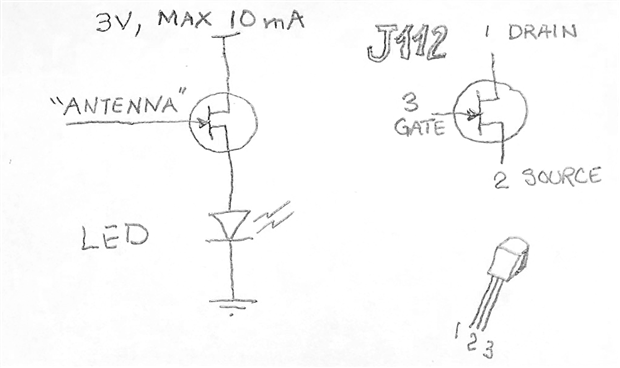In a recent element14 Essentials on Static Control, shabaz said this: "A 2N3819 + meter or LED makes a nice simple charge detector too : )"
So, I thought I would try it. I don't have a 2N3819 but I do have a J112 N-channel JFET. The circuit is shown below:
Power is supplied by a bench power supply set to 3V current limited to 10mA. The "antenna" is a 5-inch long piece of wire.
So how does it work? A JFET has extremely high input impedance - hardly any current flows into the gate - it is voltage controlled. Current flow from drain to source is determined by the voltage differential between the gate and the source. The drain to source current flow is highest when the gate to source voltage differential is zero. As the gate to source voltage differential becomes more negative the drain to source current flow decreases. At the pinch-off (sometimes called cutoff) voltage the drain to source current essentially ceases. In the detector circuit, the gate/antenna becomes negative relative to the source and the FET turns the LED off gradually as the statically charged object comes closer. I demonstrate it in the following 40-second video:
As one of the resident mechanical engineers who has never seen this demonstrated, I was suitably impressed. Comments and corrections to my understanding are always welcome 


Top Comments
-

jc2048
-
Cancel
-
Vote Up
+3
Vote Down
-
-
Sign in to reply
-
More
-
Cancel
-

fmilburn
in reply to jc2048
-
Cancel
-
Vote Up
+3
Vote Down
-
-
Sign in to reply
-
More
-
Cancel
-

jc2048
in reply to fmilburn
-
Cancel
-
Vote Up
+3
Vote Down
-
-
Sign in to reply
-
More
-
Cancel
-

shabaz
in reply to jc2048
-
Cancel
-
Vote Up
+3
Vote Down
-
-
Sign in to reply
-
More
-
Cancel
Comment-

shabaz
in reply to jc2048
-
Cancel
-
Vote Up
+3
Vote Down
-
-
Sign in to reply
-
More
-
Cancel
Children